How to Make Duck Feed Pellets at Home
Feed makes up about 50–70% of the total cost in duck farming. Buying commercial feed all the time can get expensive. Ever thought about making your own? It's cheaper and lets you adjust the mix based on your ducks' age and needs. This guide will show you how to make duck feed at home in a simple, healthy, and budget-friendly way.
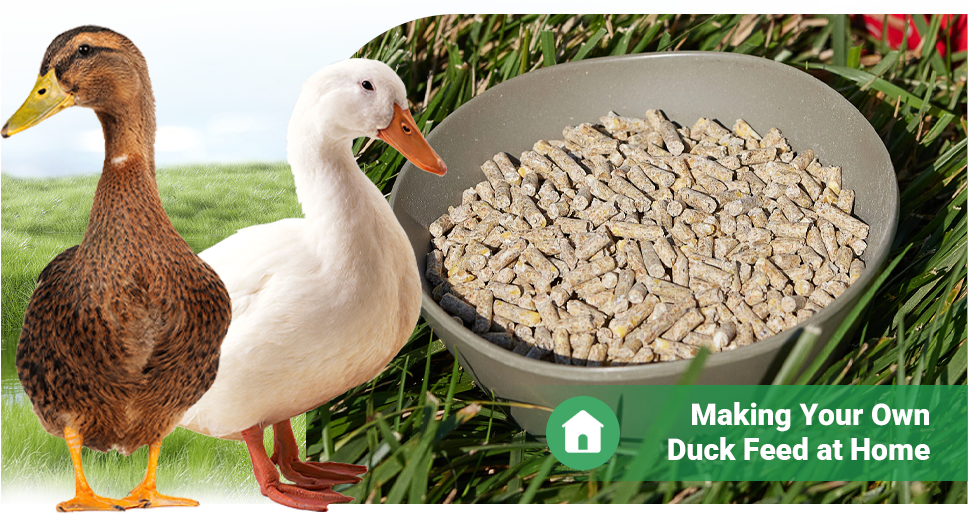
What to feed ducks?
| Stage | Key Needs | Feed Focus |
| Ducklings | High protein, easy to digest | Fine, high protein |
| Growing Ducks | Balanced diet, bone strength | Moderate protein |
| Laying Ducks | High calcium and protein | Rich, well-rounded |
Ducks need different nutrients at different stages of growth. If you want to make your own food, the first step is understanding what do duck need at each stage. That way, you can create a balanced and suitable mix for healthier ducks.
Nutritional Needs at Different Stages

Ducklings (0 to 3 weeks)
Newly hatched ducklings are still fragile. They grow quickly but have weak immunity, so their feed needs to be high in protein and easy to digest. This helps support bone and feather development. It's also important to include enough calcium and phosphorus for healthy bones.
Growing Ducks (4 to 16 weeks)
At this stage, ducks need balanced growth and strong bone structure. The protein level can be slightly reduced to prevent excess fat, which may affect later development. Calcium and phosphorus are still essential to support bone health.
Laying Ducks (17 weeks and older)
When ducks begin laying eggs, their nutritional demands rise, especially for calcium since each eggshell needs a good supply. Their feed should offer enough protein, energy, and calcium to keep egg production steady and the duck's body in good condition. Vitamins also play a key role in maintaining good health and improving laying performance.
Recommended Duck Food Recipe
Ducklings and older ducks have different nutritional needs and prefer different pellet sizes, so the feed mix should be adjusted by age.
Duckling food
Ducklings are small and still developing, with tiny beaks and immature digestive systems. The feed for duckling is better to be powder or fine pellet form that's easy to eat and digest.
spinach, leafy greens, apples, bananas, and pears. Combine these with cornmeal, soybean meal, wheat bran, and premix to make small, soft pellets. This improves both nutrition and palatability.
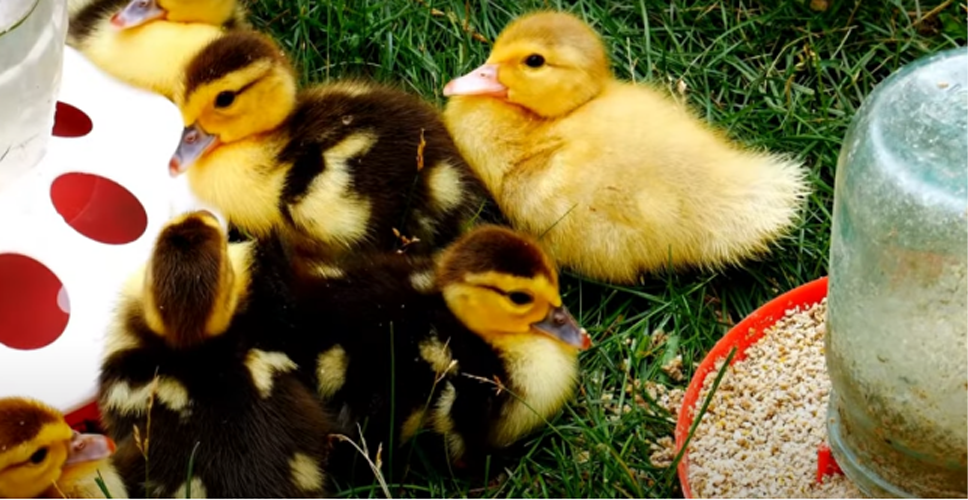
Over 3 Weeks Old
After 3 weeks, ducks develop stronger feeding ability and can gradually switch to 3 to 4 mm pellets. Compared to mash, pellets are easier to pick up, cause less waste, and tend to attract ducks to eat more. If you're curious why ducks prefer pellets, check out this article: Duck Food Secrets: Why Pellets Are Their Favorite Snack
At this stage, feed should provide enough energy and protein while keeping the calcium-to-phosphorus ratio balanced. Depending on your goals, here are two common homemade formulas you can try:
Formula 1: Budget-Friendly Feed
This mix uses low-cost, common ingredients and covers the basic needs for energy, protein, and calcium during the growing stage. It's ideal for small-scale farms focused on cost-efficiency.
| Ingredient | Recommended Ratio (%) |
| Corn | 45–50 |
| Soybean meal | 18–20 |
| Wheat bran or rice bran | 12–15 |
| Limestone powder | 1.5–2 |
| Dicalcium phosphate | 0.5–1 |
| Salt | 0.3 |
| Premix | 3–5 |
Formula 2: High-Nutrition Feed
This version offers more balanced nutrition, with higher levels of protein and calcium. It supports faster growth and is especially suitable for ducks in the laying stage.
| Ingredient | Recommended Ratio (%) |
| Corn | 40–45 |
| Soybean meal | 20–24 |
| Leafy greens or carrot powder | 5–8 |
| Wheat bran or rice bran | 8–10 |
| Vegetable oil (optional) | 1–2 |
| Limestone + Dicalcium phosphate | 3–4 |
| Salt | 0.3 |
| Premix | 4–5 |
Once you've chosen the right formula, the next step is processing. So how do you turn these raw materials into duck feed pellets? Let's walk through the step-by-step process.
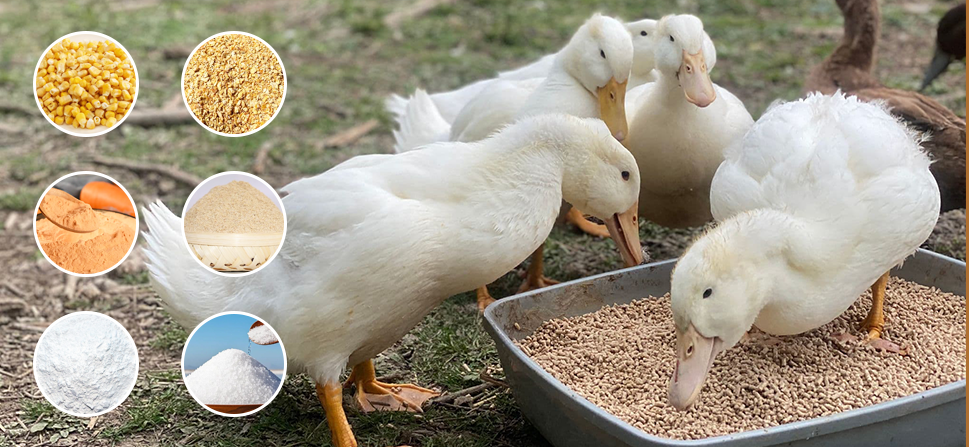
6 Simple Steps to Make your Own Duck Pellets
If you're running a small flock or just starting out, making your own duck feed can save money and give you more control over nutrition. With a small pellet machine and basic mixing tools, you can easily make pellets at home. Here's how to do it step by step:
Step 1: Prepare the Ingredients
Weigh each ingredient based on your chosen formula. Grind the dry materials and blend fruits or vegetables into a paste. For ducklings, keep the texture fine for better absorption. Older ducks can handle a coarser mix for better palatability and less waste.
Tip: If you don't have a grinder, you can buy pre-ground ingredients like cornmeal and soybean meal or ask a local mill to process them for you.
Step 2: Mix Thoroughly
Combine all ingredients in a feed mixer or large container. Mix well to ensure the nutrients are evenly distributed.
For small batches, hand mixing is okay. Just be sure to stir several times to avoid uneven mixing or settling.
Step 3: Add Water and Adjust Moisture
Spray a small amount of clean water while mixing. Aim for a moisture content of 15 to 18 percent. The mixture should hold its shape when squeezed but not drip. If it's too dry, pellets won't form well. Too wet, and you risk clogging the machine or moldy feed.
Step 4: Pelletizing
Choose the right die size based on the ducks' age:
- Ducklings: 2 to 3 mm
- Over 3 weeks: 3 to 4 mm
Feed the moistened mixture slowly and evenly into the pellet machine. The machine compresses the mix through the die to form cylindrical pellets.
Step 5: Cool and Dry
Fresh pellets come out hot and slightly moist. Spread them out in a cool, dry place to air-dry completely. This helps prevent mold and keeps the feed safe.
Step 6: Store and Feed
Once cool and dry, store the pellets in bags or plastic bins in a dry, ventilated area. For best freshness, use within 7 to 10 days.
Making duck pellets at home isn't hard. With the right method, you can lower feeding costs and adjust the formula as needed. If you're thinking about trying it, start small and experiment to find what works best for your flock.
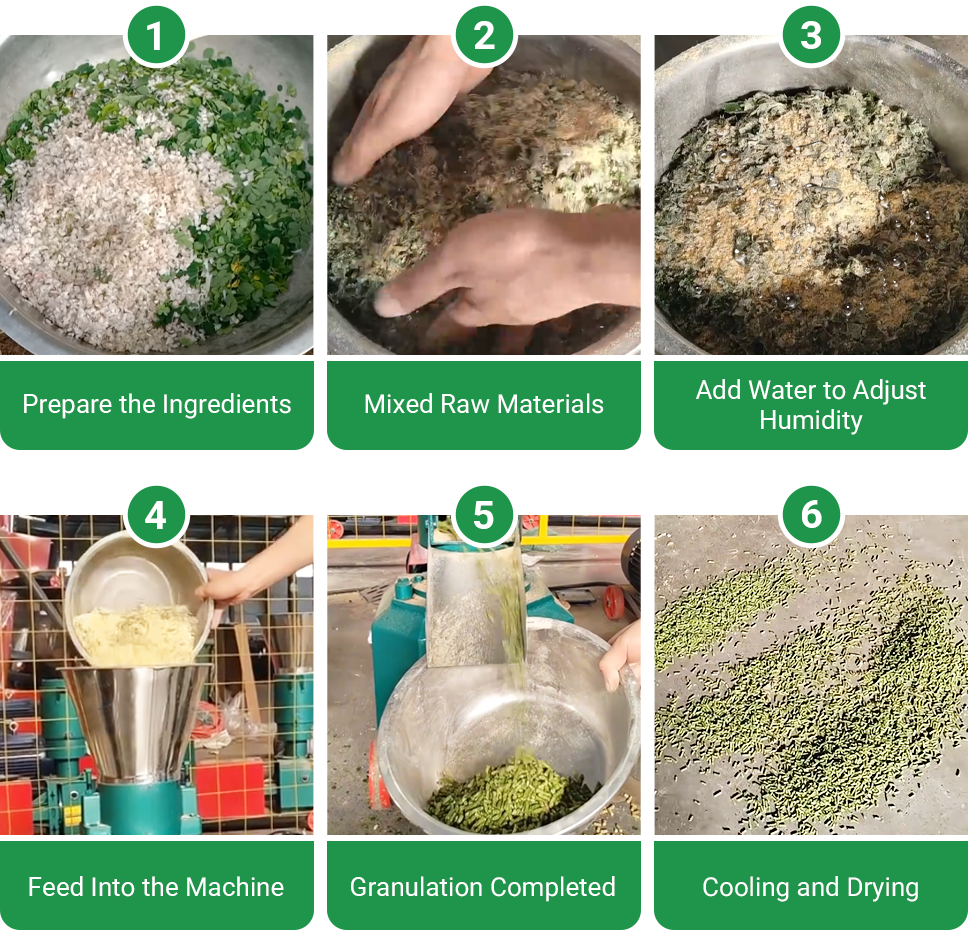
We offer pellet mills and complete feed solutions for backyard and small farms. Easy to operate, reliable output, and customizable pellet sizes. Contact us to get the right setup for your needs.
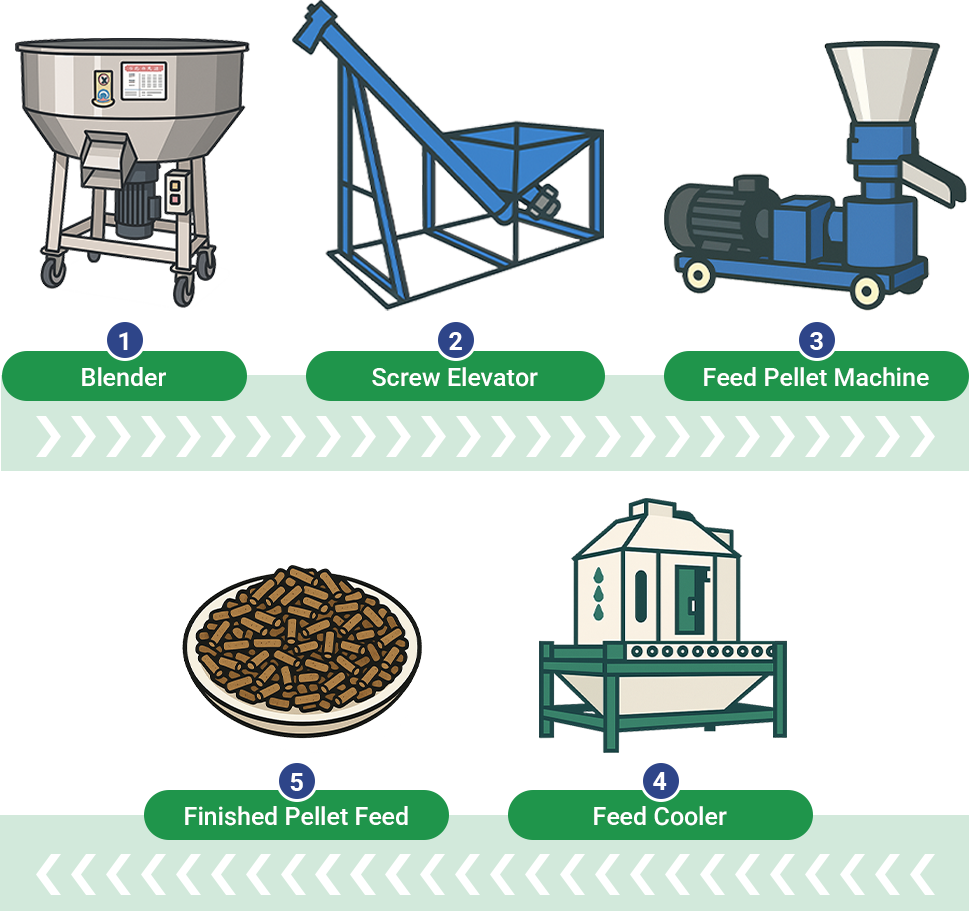
FAQ
Can I make duck feed without a pellet machine?
It's possible, but not ideal. Mash or wet feed works for ducklings, but ducks over 3 weeks prefer pellets. Without a machine, it's hard to form proper pellets. A small pellet machine is a low-cost investment and much more efficient than buying feed long-term.
How much feed can a pellet machine produce?
Small pellet machines typically produce 100 to 500 kg per hour. Once the pellets are fully cooled and dried, store them in a dry, ventilated place. They usually stay fresh for 7 to 10 days, so it's best to make them in batches.
Can feed ducks bread crumbs?
Occasionally is fine, but not as a regular feed. Bread lacks essential nutrients like protein, vitamins, and minerals. It's also high in salt and can mold easily. Over time, it may cause health issues.
Do pellets cause diarrhea in ducklings?
Possibly, but not always because of the feed. Pellets that are too big, too hard, or poorly made can upset their stomach. Dirty water, sudden weather changes, or stress can also cause diarrhea.
Can ducks eat chicken layer pellets?
Yes, but with caution. Laying hens' feed is high in calcium and protein, so it can work for egg-laying female ducks in small amounts. However, it's not suitable for drakes or non-laying ducks, as it may affect their health over time.

 Online Contact
Online Contact Send Message
Send Message
Need Some Help?
Contact us quickly and we will reply you within 24 hours. We will not disclose your information.